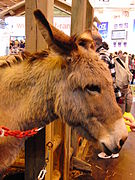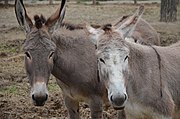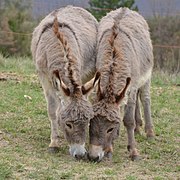|
Provence Donkey
The Provence Donkey, French: Âne de Provence, is a breed of domestic donkey from Provence, in south-eastern France. It is now distributed through much of central and south-east France, with the highest concentration in Provence and the Rhône-Alpes region.[6] For hundreds of years the Provence donkey was used by transhumant shepherds of the area as a pack animal in the seasonal movement of flocks of sheep between their summer pastures on the high Alps of Haute-Provence and the Dauphiné and their winter grounds in Basse-Provence.[7] HistoryThe earliest records of the use of donkeys by shepherds in Provence are from the fifteenth century. During the seasonal transhumance between the low ground where the sheep over-wintered and the high alpine pastures where they spent the summer months, donkeys were used as pack animals. They carried, on specially adapted pack-saddles, the equipment and supplies needed by the shepherds along the journey.[5][7] The area of origin of the breed appears to coincide exactly with the area, consisting of Provence and parts of Savoie and the Ardèche, where transhumant sheep-farming was traditional.[7] Following the mechanisation of transport in the twentieth century, first by rail and then by road, the breed declined at an alarming rate. At the end of the 19th century, a census in the départements of Provence recorded 13,000 head; in 1956 the number had fallen to around 2000, and by 1993 no more than 330 could be identified.[6] A breeders' association, the Association de l'Âne de Provence, was formed in December 1992,[8] and worked with the Haras National, the national stud, of Uzès, in Languedoc-Roussillon, to achieve recognition of the breed. A stud-book was opened in December 1995,[9] and in November 2002 the Provence donkey received the official recognition of the Ministère de l'agriculture, de l'alimentation, de la pêche et des affaires rurales, the French ministry of agriculture.[10] The current population is estimated at 1500.[6] DescriptionAt three years old, Provençal jacks stand 1.20–1.35 metres (47–53 in) at the withers, and jennies 1.17–1.30 m (46–51 in).[4] The coat is dove grey, varying from pale to dark, with pinkish lights. The muzzle and surround of the eyes are pale; the forehead and ears usually have a russet tint. There is a well-marked darker dorsal stripe and shoulder-stripe; zebra-striping of the legs may be present. The limbs are solid and the hooves relatively large.[5] UseProvençal donkeys are still used in transhumance by some shepherds.[6] The Provence Donkey is suitable as a pack animal, for light driving and for riding. Its character and sure-footedness even on broken ground make it suitable for trekking. It may be used in vegetation management, for brush clearance to reduce fire risk.[7] References
Information related to Provence Donkey |
||||||||||||||||||||



